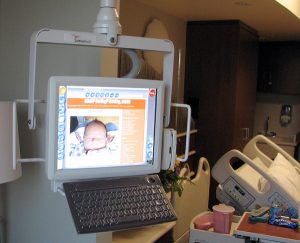
Poor usability and design flaws of electronic health records (EHRs) can pose safety risks to patients, according to recent studies.
A recently-issued report urges more oversight and post-market testing to ensure that EHRs don’t inadvertently harm patients. The report was the result of a collaboration of the Pew Charitable Trusts, the American Medical Association and MedStar Health’s National Center for Human Factors in Healthcare.
The 57-page report may be helpful for journalists who seek to familiarize themselves with some of the existing usability problems with EHRs, and how they can pose a risk to patients.
Additionally, the best practice recommendations provide some topics for reporters to consider when they are covering the implementation and use of EHRs at local hospitals and medical groups. These include:
- What is the governance oversight in selecting and implementing an EHR system? What is the method for personnel to report health IT safety hazards?
- How are staff and clinicians trained on the systems, and is there ample time set aside for this training?
- Were developers allowed to observe clinician workflows for optimal design, and did personnel have input into design decisions?
Ongoing safety challenges with EHRs can occur with data entry, alerts, visual display, information availability, interoperability, system automation and defaults, according to the report.
For instance, a wrong time or date default in the EHR can cause a delay in medication dosing for a hospitalized patient. Or, if a patient allergy is documented in the EHR as free text instead of encoded text, an alert may not pop up when an attending physician orders a medication the patient is allergic to, according to the report.
Typically, these usability problems only become obvious after-market, meaning after the product is made and installed at hospitals. Additionally, hospitals frequently request customizations to the EHR, which may not have been tested by the vendors, according to the report.
The report authors recommend voluntary criteria for EHR developers and health care providers to improve usability and safety.
The report offers “immediate steps that hospitals and health care software vendors can take to protect patients from unforeseen hazards and help ensure that EHRs can reach their full potential to transform health care,“ wrote Ben Moscovitch, project director of Health IT at Pew in a related article.
A number of efforts are underway to resolve the challenges around technology and patient harm, including the Partnership for Health IT Patient Safety. The 21st Century Cures Act of 2016 requires the development of voluntary certification criteria for pediatric EHRs by the end of 2018. The Office of the National Coordinator for Health Information Technology (ONC) is expected to release the criteria this fall.
More coverage of the Pew/AMA/MedStar report:
- EHRs seen as safety trap for doctors, Bloomberg News
- Pew, AMA: 6 components to consider when assessing EHR safety, Becker’s
- Safety-test your EHR, HealthLeaders Media








